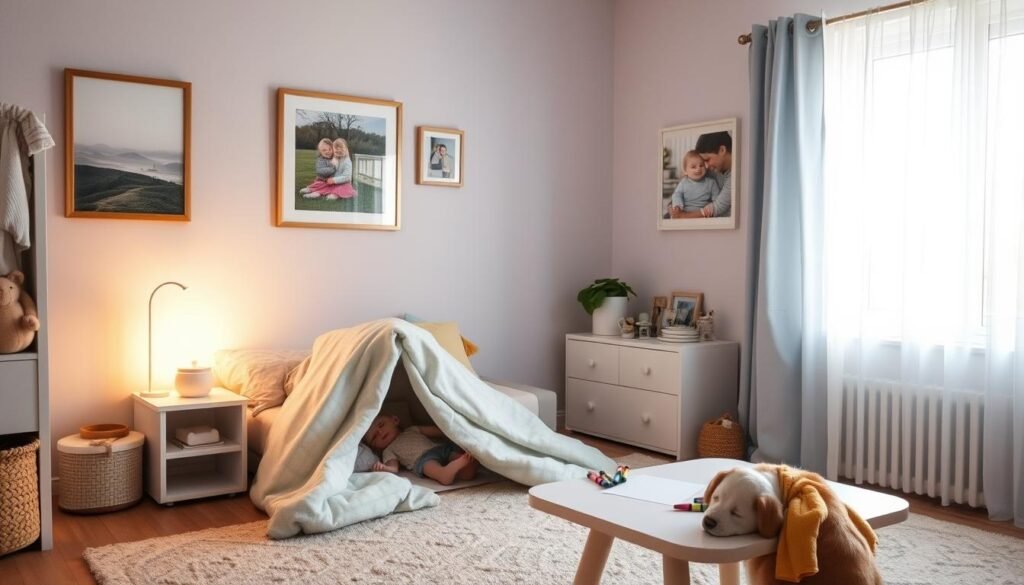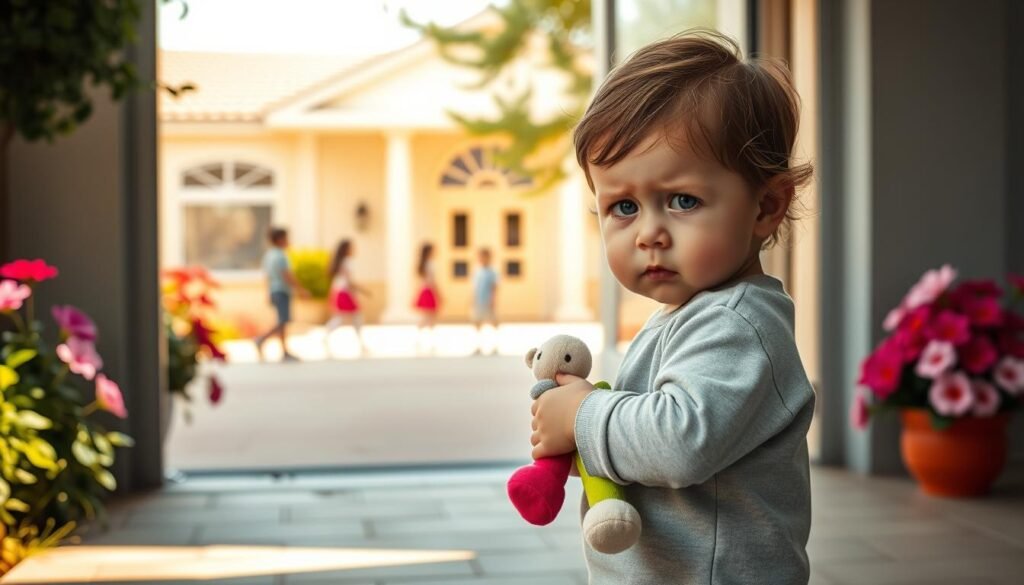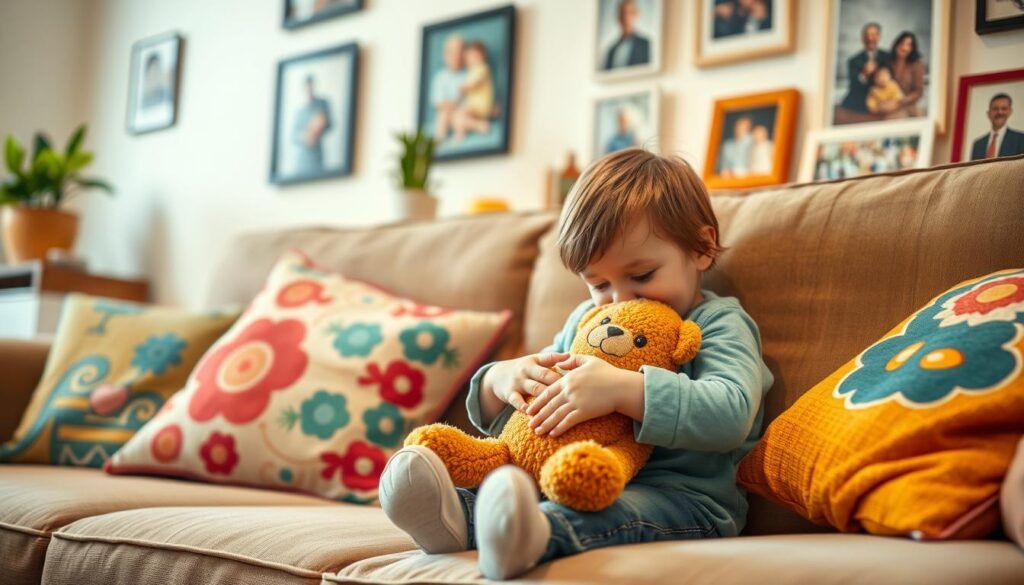Did you know that nearly 30% of kids feel separation anxiety before becoming teenagers? This issue mainly shows up in children aged 18 months to 3 years. They begin to cling more to the people who take care of them. While most children might feel a little upset for a short time, some have stronger reactions. These reactions can impact their day-to-day activities. It is important for parents to understand separation anxiety. This understanding helps them support their children through this tough but normal development stage. This is key when looking at childhood anxiety disorders. Spotting the signs and using the right parenting strategies for separation anxiety can help. It helps kids handle their feelings better when they’re away from their caregivers.
Key Takeaways
- Separation anxiety is common in children, particularly between the ages of 18 months and 3 years.
- Around 30% of children may face significant separation anxiety before the teenage years.
- Understanding separation anxiety helps in navigating childhood anxiety disorders.
- Effective parenting tips can alleviate anxiety during times of separation.
- Some children may experience prolonged separation anxiety that affects their daily activities.
Understanding Separation Anxiety
What is Separation Anxiety in Children? It’s a stage many kids go through while growing up. Usually, it starts from ages 8 to 14 months. Kids at this age get upset when they’re away from their main caregiver. They are learning that people they love are still there, even if they can’t see them. This learning leads to more worries when they’re apart.
By the age of 2, children start to understand that their parents will come back. Most kids show signs of missing their parents, especially in new or scary places like hospitals. However, some might show extreme signs of fear. This includes too much worry when apart, bad dreams, not wanting to go to school, feeling sick, or fearing something bad will happen to their caregiver. These serious reactions can really impact how a child feels and lives.
The Causes of Separation Anxiety in Kids are complex. Studies show that stressful events or losing someone important can start this problem. Also, kids whose families have a history of anxiety are more at risk. Getting help early if you see signs of too much worry is key. It’s very important to understand this part of growing up. That way, we can support our kids through their struggles with separation and building close bonds.
What is Separation Anxiety in Children?
Learning about Separation Anxiety in kids is key for parents to help them cope. It starts at about 6-7 months old and peaks at 14-18 months. Kids during this time might show a deep fear of being away from their caregivers. They might cry, cling, or refuse to go to places like school without them.
About 4% of young kids and school-aged children face tougher forms of this anxiety. It can really affect their day-to-day life, making it hard for them to socialize, learn, and be independent. Kids with severe symptoms might also feel physical pains, like stomach aches, or have scary dreams.
Parents need to realize that while it’s a common stage of growing up, knowing the signs of Separation Anxiety is important. This knowledge helps them support their child the right way. Symptoms of Separation Anxiety vary: older kids might talk about their worries, but younger ones show it in their actions. Places like the Kids Helpline offer support for kids over five, giving them someone to talk to when they need it.
To help kids through their fear of being apart, try practicing short goodbyes. This can help them get used to the idea slowly. If the anxiety doesn’t improve, it might be time to see a professional for extra help. Understanding and addressing their fears early can really make a difference in their life ahead.
Symptoms of Separation Anxiety
It’s vital for parents and caregivers to recognize the symptoms of Separation Anxiety. These symptoms can vary with age. This knowledge helps caregivers support their children effectively. Quick understanding leads to faster help and treatment.
Common Signs in Infants and Toddlers
For babies and young children, signs often show in their emotions and behavior. Common indicators include:
- Tearful goodbyes when a caregiver leaves.
- Crying episodes triggered by separation.
- General agitation in new places.
- Worry about their needs not being met without a familiar person.
Between 18 months and 3 years, many children show some separation anxiety. It’s usually a phase that gets better by age 2 or 3. However, Separation Anxiety Disorder symptoms are stronger and last longer.
Signs in Older Children and Teens
As kids get older, their signs may change. They might:
- Not want to do things outside the home, like going to school.
- Have physical symptoms like stomachaches or headaches from anxiety.
- Have bad dreams about being separated.
- Experience panic attacks at the idea of being apart.
Studies show that 3% of kids carry separation anxiety into elementary school. About 8% of teens 13 and up also struggle with it. Support from teachers and caregivers is key. They help kids feel safe. Early help can make life much better for these children. For more details, visit this resource.
Causes of Separation Anxiety in Kids
It’s vital for parents to understand the Causes of Separation Anxiety in Kids. This complex disorder stems from both biological and environmental factors. Recognizing these elements can help parents support their children more effectively.
Biological Factors
Biological elements have a big role in separation anxiety. An imbalance in neurotransmitters, such as norepinephrine and serotonin, might make kids feel more anxious. Also, a child’s genetic background is important. If anxiety or mental health issues run in the family, a child might be more prone to anxiety.
In the U.S., about 4%-5% of kids aged 7 to 11 suffer from this disorder. This shows that biology significantly impacts their emotional state.
Environmental Influences
The environment also affects the Causes of Separation Anxiety in Kids. Stressful events like trauma or big life changes can increase anxiety. For example, moving or a family divorce can be tough on kids.
Moreover, kids often pick up on their parents’ feelings and behaviors. If a parent struggles with anxiety, it can influence how their child handles separation. This highlights the role of the family environment in shaping a child’s emotional responses.
Understanding these causes allows parents to better support their kids. It helps in fostering a nurturing environment for their emotional health.
How Long Does Separation Anxiety Last?
Separation anxiety varies among kids. Some might show signs as early as 6 months, peaking around 8 to 18 months. It starts when kids begin to understand that things still exist, even if they can’t see them. For many toddlers, this anxiety can last several months, but for others, it might go on for years.
As kids get older, they usually feel less anxious about being apart. But, hard times like getting sick or big changes can bring the anxiety back. Starting daycare or getting a new brother or sister are examples that can trigger this worry. Parents may see their kids get very upset when they have to leave them.
Some kids only get anxious now and then, while others may have a tough time saying bye all through their early years. Studies point out there might be a genetic reason why some kids face more anxiety. If a kid’s anxiety stops them from doing everyday things and lasts over four weeks, it might be more serious, like separation anxiety disorder.
Coping Strategies for Separation Anxiety
Many children experience separation anxiety, posing challenges for them and their caregivers. Effective coping strategies can make this period easier. Knowing how to apply these strategies is key to fostering independence in kids.
Practicing Short Separations
Practicing brief separations is a top method for easing this anxiety. Parents can start with short periods away from their child. As the child adjusts, the time apart can gradually increase. This helps them get used to separation. It builds their confidence and reduces their fear of being away from their caregivers.
During these times, it’s important for parents to stay calm. This shows the child that they will come back.
Establishing a Goodbye Ritual
Having a consistent goodbye ritual helps kids with separation anxiety. It offers them a predictable way to handle parting. The ritual could be a special phrase or a hug. It signals it’s time for the caregiver to leave.
This routine makes children feel secure about their caregiver’s return. It helps them emotionally. Parents should think of unique ways to make these rituals comforting.

For more help with this phase, parents can look at educational materials. These guides offer insights into separation anxiety. They explain how to recognize signs and cope effectively.
Parenting Tips for Separation Anxiety
Helping kids deal with separation anxiety is key in parenting. It helps ease their emotions. Effective methods include recognizing and addressing triggers while also boosting independence. This way, kids can handle separations with more confidence.
Recognizing Stress Triggers
It’s critical for parents to spot what stresses their kids. Common triggers are:
- Hunger or fatigue
- Changes in routine
- New places, like starting school
- Big family changes, such as divorce or moving
- Peer pressure or social worries
Knowing these triggers lets parents plan better for separations. Keeping a routine and ensuring kids are rested can lessen anxiety. It helps them handle tough situations better.
Encouraging Independence
Building independence in kids is important for reducing separation anxiety. Parents can help by:
- Allowing playdates to improve social skills
- Signing up for activities away from home
- Letting them make choices, like picking clothes or toys
- Slowly introducing short times apart, then gradually longer ones
This not only fosters independence but also teaches coping skills for later. A routine with gradual separations raises their confidence in new situations.
School Separation Anxiety
School separation anxiety often starts in kids, especially those 5-7 and 11-14 years old. These ages mark their entry into elementary and middle school. A child might get more anxious after being really close to their parents, like during summer or holiday breaks. These times can make the thought of returning to school harder, so it’s key for care providers to spot the symptoms of separation anxiety.

- Clinging behavior
- Excessive worry about parents or their own safety
- Difficulty sleeping and nightmares
- Exaggerated fears of animals or frightening situations
- Severe tantrums when faced with school attendance
If not dealt with, school separation anxiety can impact someone well into adulthood. It may evolve into anxiety or panic disorders later on. This makes early help essential. An expert mental health professional should be consulted for kids showing serious signs.
Pediatric providers play a crucial role in spotting and treating separation anxiety. They help diagnose and manage it properly. However, many kids don’t get the help they need. This is often because there aren’t clear guidelines for doctors to follow. By raising awareness, we can make sure kids get the right support as they grow.
Attachment and Separation Anxiety
The way a child connects with their caregiver is super important. It shapes how they handle being apart later. Kids who feel securely attached to their caregivers usually get less anxious when not together. This is because caring and responsive parents build strong, healthy connections.
Kids who don’t get enough attention or care early on might struggle more with being apart. They can become very upset when separated from their loved ones. Studies show that being apart for a long time when very young can cause big problems. It might even lead to personality disorders when they grow up.
From six to nine months, babies start to show big feelings like fear and anger. This is normal. By the age of three or four, if they’ve had loving care, their worry about being apart starts to fade. If kids are in places where they don’t get much emotional support, they have a harder time feeling secure.
But there are ways parents can help ease separation worry. Making routines and slow introductions to being apart can help. With the right support, youth can form strong, healthy bonds. This helps prevent issues with anxiety about being apart as they get older.
Treating Separation Anxiety in Children
Treating separation anxiety in kids needs a custom approach. It looks at each child’s own symptoms and needs. Methods like Cognitive Behavioral Therapy (CBT) are key in treating it. CBT helps kids learn how to cope. It also uses exposure therapy to gently introduce kids to being apart. This builds their resilience against anxiety.
Therapeutic Approaches
Behavioral therapies, like systematic desensitization and flooding, help reduce anxiety from being apart. They do this by slowly getting kids used to separation in safe places. This lessens their anxiety over time. Psychotherapy also plays a big part in improving kids’ emotional health. Having a professional’s help is often crucial for success.
The Role of Medication
Sometimes therapy isn’t enough, and meds may be needed. Older kids might get SSRIs. These can lift mood and cut down on anxiety. But parents should know about possible side effects like drowsiness and dry mouth. In extreme cases, these meds might also increase suicide risk. Drugs like anxiolytics might be used, but they can be habit-forming, so care is needed.

| Treatment Approach | Description | Consideration |
|---|---|---|
| Cognitive Behavioral Therapy (CBT) | Equips children with coping skills to manage anxiety. | Highly effective for various anxiety disorders. |
| Exposure Therapy | Gradually introduces children to separation in safe doses. | Reduces anxiety over time through controlled exposure. |
| Medication (SSRIs) | Antidepressants used when therapy is insufficient. | Potential side effects require careful monitoring. |
| Anti-anxiety Medication | Occasionally prescribed but caution is needed. | Possible habit-forming qualities and side effects. |
Monitoring and Assessing Anxiety Levels
Keeping an eye on kids’ anxiety levels is key in handling childhood anxiety, especially separation anxiety. Parents should watch for symptoms, spot what causes them, and check how their child feels overall. Keeping notes on these can help decide if a child needs more help or not.
The Revised Child Anxiety and Depression Scale (RCADS) is a great tool for parents. It’s a questionnaire with 47 items that looks into a kid’s anxiety symptoms. It covers several types of anxiety, including separation anxiety. The RCADS shows that separation anxiety disorder affects 7.6% of teens between 13-18 years old.
Talking regularly with teachers and doctors is crucial. These chats can give new insights, helping to see the full picture of a child’s condition. Parents need to ask detailed questions about their child’s anxiety. This can bring to light problems that might need special attention.
- Track daily mood fluctuations and instances of anxiety.
- Utilize standardized questionnaires like the RCADS.
- Engage in talks with teachers about classroom behavior and social interactions.
Knowing the level of anxiety is vital for setting up the right treatment and coping tactics. Finding and treating childhood anxiety early can improve life for kids a lot.
How to Support Your Child During This Phase
Helping your child through separation anxiety is key for their growth. Parents can create a caring environment by talking openly about emotions. It’s important to reassure your child they are safe. This builds their courage to face fears. By using Parenting Tips for Separation Anxiety, caregivers should encourage kids to be independent. This teaches them to manage on their own in new situations.
Signs of separation anxiety include lots of questions and more worry when apart. A child might have trouble sleeping or focusing, and might avoid certain situations. When parents support and understand their child’s feelings, it makes the child feel valued and heard.
- Finding out if a child is anxious is crucial. Common signs are:
- Crying when separated
- Being clingy in new places
- Needing a lot of reassurance
Creating a stable routine helps children with separation anxiety feel safe. Starting slow with partings, based on what the child can handle, helps. A special toy or blanket can make the child feel connected even when you’re not there.
If a child is still very anxious after two to three weeks in a new place, getting professional advice is a good idea. Cognitive Behavioral Therapy (CBT) can teach kids how to calm their anxiety and comfort themselves.
Teenagers also benefit from learning to manage tasks on their own, like cooking or planning their day. This is especially true during big changes, like going to college. Cutting back on calls and texts during these times can help them grow more independent and strong while they learn to handle separation anxiety.
Conclusion
It’s key for parents to understand separation anxiety to support their children well. Knowing the symptoms and coping methods can make kids feel more secure. Since the levels of separation anxiety vary among children, personalized approaches are needed.
A child’s separation anxiety can be impacted by how they’re parented. Overprotective or controlling parents may cause higher anxiety. Thus, it’s important for parents to find a balanced way to raise their children. This will help kids develop in a healthy emotional way.
Even though separation anxiety is common in kids, parents should be proactive. Being informed helps children deal with separation confidently. Ultimately, creating a supportive home and using the right strategies can help overcome the challenges of separation anxiety.